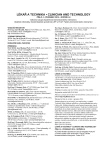Solution of the Cross-talk problem in cell impedance analysis of cardiac myocytes
Membrane capacitance is a fundamental electrical characteristic of the surface membrane of living cells. The membrane capacitance is quantitatively related to the surface area, thickness and dielectric properties of the cell membrane and thus provides valuable information about the state of the cell. A generally accepted method for measuring membrane capacitance is based on stimulation of the cell with rectangular voltage pulses and approximation of the recorded membrane current by a mono-exponential decay function. We found that in cardiac muscle cells this method provides high variability of the measured capacitance and large cross-correlation among parameters of the measured circuit. In this study we focused on the elimination of cross-correlation error between the membrane capacitance, the membrane resistance, and the access resistance of the recording set-up. We showed how the use of the standard approximation model affects the level of crosstalk between estimates of these parameters. We proposed a modified model and tested its applicability on simulated and experimental data. The results revealed that the crosstalk error can be reduced by three orders of magnitude, well below the natural variability of membrane capacitance arising from biological reasons in cardiac myocytes.
Keywords:
Membrane capacitance, cardiac myocyte, impedance measurement, crosstalk
Autoři:
Matej Hoťka 1,2; Ivan Zahradník 1
Působiště autorů:
Department of Muscle Cell Research, Institute of Molecular Physiology and Genetics, Slovak Academy of Sciences, Bratislava, Slovakia
1; Department of Biophysics, Faculty of Science, Pavol Jozef Šafárik University, Košice, Slovakia
2
Vyšlo v časopise:
Lékař a technika - Clinician and Technology No. 4, 2014, 44, 10-14
Kategorie:
Původní práce
Souhrn
Membrane capacitance is a fundamental electrical characteristic of the surface membrane of living cells. The membrane capacitance is quantitatively related to the surface area, thickness and dielectric properties of the cell membrane and thus provides valuable information about the state of the cell. A generally accepted method for measuring membrane capacitance is based on stimulation of the cell with rectangular voltage pulses and approximation of the recorded membrane current by a mono-exponential decay function. We found that in cardiac muscle cells this method provides high variability of the measured capacitance and large cross-correlation among parameters of the measured circuit. In this study we focused on the elimination of cross-correlation error between the membrane capacitance, the membrane resistance, and the access resistance of the recording set-up. We showed how the use of the standard approximation model affects the level of crosstalk between estimates of these parameters. We proposed a modified model and tested its applicability on simulated and experimental data. The results revealed that the crosstalk error can be reduced by three orders of magnitude, well below the natural variability of membrane capacitance arising from biological reasons in cardiac myocytes.
Keywords:
Membrane capacitance, cardiac myocyte, impedance measurement, crosstalk
Zdroje
[1] Neher, E., Marty, A. Discrete changes of cell membrane capacitance observed under conditions of enhanced secretion in bovine adrenal chromaffin cells. Proc Natl Acad Sci USA, 1982, vol. 79, no. 21, p. 6712–6716.
[2] Thompson, R. E., Lindau, M., Webb, W. W. Robust, high-resolution, whole cell patch-clamp capacitance measurements using square wave stimulation. Biophys J, 2001, vol. 81, no. 2, p. 937–948.
[3] Hotka, M., Zahradnik, I. FluctuationAnalyzer 2014, http://sourceforge.net/projects/fluctuationanalyzer/
[4] Novak, P., Zahradnik, I. Q-method for high-resolution, whole-cell patch-clamp impedance measurements using square wave stimulation. Ann Biomed Eng, 2006, vol. 34, p. 1201-1212.
[5] Mason, M. J., Simpson, A. K., Mahaut-Smith, M. P., Robinson, H. P. C. The interpretation of current clamp recordings in the cell-attached patch-clamp configuration. Biophys J, 2005, vol. 88, p. 739–750.
[6] Lindau, M., Neher, E. Patch-clamp techniques for time-resolved capacitance measurements in single cells. Pflugers Arch, 1988, vol. 411, no. 2, p. 137-146.
[7] Sigworth, F. J., Affolter H., Neher, E. Design of the EPC-9, a computer-controlled patch-clamp amplifier. 2. Software. J Neurosci Methods, 1995, vol. 56, p. 203–215.
Štítky
BiomedicínaČlánok vyšiel v časopise
Lékař a technika

2014 Číslo 4
Najčítanejšie v tomto čísle
- REAL-TIME visualization of multichannel ECG signals using the parallel CPU threads
- Differences in sleep patterns among healthy sleepers and patients after stroke
- Pulmonary fluid accumulation and its influence on the Impedance Cardiogram: CompariSON Between a Clinical Trial AND FEM Simulations
- EFFECT OF THE PLACEMENT OF THE INERTIAL SENSOR ON THE HUMAN MOTION DETECTION
